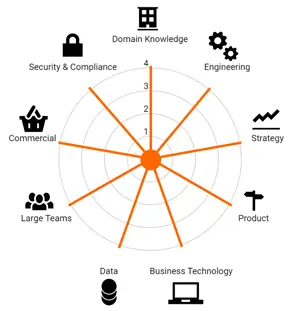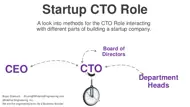The Chief Technology Officer (CTO) is the executive responsible for overseeing an organization's technological needs as well as its research and development (R&D). Also called the Chief Technical Officer, this individual examines an organization's short-term and long-term needs and uses capital to invest in ways designed to help the organization achieve its goals. The CTO typically reports directly to the Chief Executive Officer (CEO) of the company.
Previously a Chief Information Officer (CIO) performed both the CIO and Chief Technology Officer (CTO) roles. However, as technology continued to advance, there was an increasing need to separate the CIO role into two roles to ensure company success. The CTO takes on the strategic planning role, while the CIO focuses on the technology.
The CTO is the highest executive technology position in a company and leads the technology or engineering department. The CTO develops policies and procedures and leverages technology to enhance customer-facing products and services. The CTO also develops strategies to increase revenue and performs cost-benefit analysis and return on investment analysis.
Large companies with big budgets have a CTO, CIO, or both. Many large companies require both a CTO and a CIO, while smaller companies have one or the other. The choice depends on the company's vision and budget
While R&D are component of businesses, the evolution of information technology (IT) and computing has increased the importance of the chief technology officer. Companies focused on science and electronics products employ CTOs responsible for overseeing intellectual property and having industry foundations.
However, a CTO's responsibilities and role also depend on the company. Typically there are four different types of CTOs, whose main duties may differ.
Infrastructure - This CTO may oversee the data, security, maintenance, and networking of the company and may implement (though not necessarily establish) the company's technical strategy. The CTO may also manage the company's technology roadmap.
Planning tool - This CTO role may envision how technology will be used within the company while establishing the technical strategy for the company. This CTO will also consider further deploying new technologies in the company to ensure success.
Consumer-focused - In this role, the CTO will serve as a liaison between customers and the business by taking on customer relationship responsibilities, understanding target markets, and helping bring IT projects to market.
Thinker - The CTO will help establish the company's strategy and technology infrastructure, analyze target markets, and create business models. Additionally, the CTO will have a close relationship with the Chief Executive Officer and other senior management members of the company.

This position is considered one of the most ambiguous C-level roles because a CTO's responsibilities depend on several factors such as the startup model, business handling style, in-house and outsourced headcount, and more. Therefore, there is no certainty relating to salary. In 2020, the average salary for the CTO position globally was $159,920 per year. However, blue chip companies like IBM and Boston Dynamics provide annual salaries of around $200,000.
CTOs will also struggle to find a general starting job description. The only thing they can be certain of is the primary duty of the Chief Technology Officer is to support a company in achieving financial and marketing goals by employing an advanced technological method.
Own all of the company's technology services and external products. Manage engineering and developer teams. Develop company strategy to leverage technology resources. Lead strategy for technology platforms, external relationships, and partner networks. Establish overall technology standards and best practices within the company. Support departments in profitably leveraging technology. Implement new infrastructure and systems. Oversee infrastructure systems to ensure functionality. Protect all technology data. Manage product, task, and deadline roadmaps. Advanced CTOs have product and project management skills. Delegation: CTOs should perform frontline and be able to delegate work. Communicate technology agenda in staff meetings. Oversee IT budgets and KPIs. Work with stakeholders Provide feedback to communicate technology adjustments. Communicate strategic aspects of technology to partners. Keep up with all technology trends and best practices. Closely coordinate with Business Development, Marketing, and Operations.

By logic, any CTO must have deep expertise in both operational management and software development. The list of skills required to become a CTO is quite long. Here, we identify the main requirements:
Experience working as a CTO or in other leadership roles.
Foundational knowledge related to technology trends.
Leadership and organizational abilities.
Deep technical knowledge related to computer science and engineering; additionally - architecture, design, and web system development.
Experience managing projects.
Ability to conduct technology research and analysis.
Understanding of business planning and budgets.
Enhanced communication skills.
Problem-solving abilities.
Strategic thinking.
Excellent time management skills.
Effective negotiation skills.